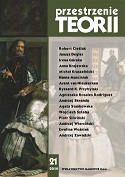Hermeneutyczne rozumienie W-cielenia i Eucharystii: „Tenebrae” Paula Celana i interpretacyjny charakter kom-unii poprzez ciało, krew i obraz
Hermeneutic understanding of the Incarnation and the Eucharist: Paul Celan’s Tenebrae and the interpretive nature of communion through body, blood and image
Author(s): Andrzej WiercińskiSubject(s): Christian Theology and Religion, Studies of Literature, Theory of Literature
Published by: Uniwersytet Adama Mickiewicza
Keywords: The Hermeneutics of the Incarnation; Eucharist; communion; Paul Celan; "Tenebrae"; Gadamer's hermeneutics;
Summary/Abstract: Carnal hermeneutics shows that pre-thematic bodily hermeneutics can complement cognitive hermeneutics. The thematization of sacramental imagination is an essential part of such an approach. Carnal hermeneutics finds new ways of showing how imagination inhabits our bodies and reflects on the emancipatory possibilities that are hidden in the process of maintaining and crossing the various boundaries that constitute our identity. Carnal reading is both reception and creation, i.e., it is not a reading into something but a reading from something. The act of interpreting Paul Celan’s Tenebrae is an exercise in a diacritical hermeneutics of communion and prayer, which contributes to the self-awakening of existence by elucidating the fundamental structures of our understanding of being.
Journal: Przestrzenie Teorii
- Issue Year: 2014
- Issue No: 21
- Page Range: 299-308
- Page Count: 10
- Language: Polish

